It has been reported that the U.S. Air Force is expected to purchase the E-7 Wedgetail airborne early warning and control aircraft at some point next year.
BreadkingDefense report here that Boeing expects the US Air Force to announce plans to purchase its E-7 Wedgetail airborne early warning and control aircraft in 2022.
“I’m very confident that the Air Force is choosing the E-7 to replace its E-3 fleet,” Mike Manazir, Boeing’s vice president for defence business development, was quoted by Valerie Insinna during a news conference ahead of the Dubai Airshow.
He added:
“I believe they’ll be announcing sometime in 2022 that they’re going to move forward on the E-7.”
Boeing, the manufacturers, say that the E-7 Wedgetail is one of the world’s most advanced, capable and reliable Airborne Early Warning and Control (AEW&C) platforms, “having proven itself in operations around the world”.
The aircraft is designed to track multiple airborne and maritime targets simultaneously. It can provide situational awareness and direct other assets such as fighter jets and warships.
Australia, South Korea and Turkey already operate the aircraft. The Uk has ordered some. The UK’s E-7 Wedgetail aircraft (the order has been cut from five to three) is expected to be in service with the Royal Air Force in 2023.
UK E-7 timeline:
- March 2019: UK Ministry of Defence (MOD) announced its selection of the Boeing E-7 Airborne Early Warning and Control (AEW&C) aircraft for the RAF.
- Early 2020: The first two 737 NG aircraft set to become RAF Wedgetails start the early stages of conversion in the United States.
- May 2020: STS Aviation Services in Birmingham named as key Wedgetail supplier to carry out the modification work, creating more than 100 highly skilled jobs: 90 with STS and 30 more with Boeing.
- May 2020: Leonardo and Thales UK will develop the aircraft’s defensive aids system, adding a UK designed and built technology to the fleet.
- November 2020: Fuselage sections for first RAF E-7 Wedgetail aircraft arrive at conversion site in Birmingham.
- January 2021: The first aircraft to become a Wedgetail lands at Birmingham Airport.
- September 2021: The second aircraft to become a Wedgetail lands at Birmingham Airport. It joins the first aircraft to undergo conversion with Boeing’s supply chain partner STS Aviation.



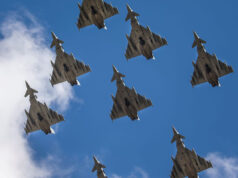

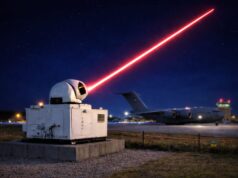
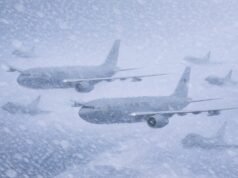
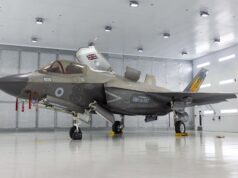
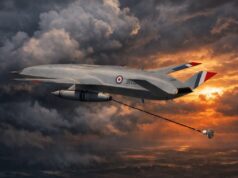
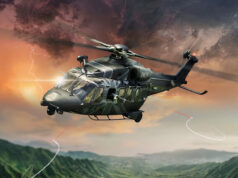




This seems to be a big vote of confidence in this plane and it’s capabilities. Is there now a possibility of the RAF ordering back an additional 2 if the price comes down with the USAF order?
One can only hope.
Plus some extra P8s… It’s all been said here before.
Plus, the USN is said to be using 3x P-8 in the SIGINT/ELINT role. A replacement for Rivet Joint in USAF/RAF service perhaps?
Rivet Joint will operate to 2035, by then there will probably a dedicated replacement
Yeah cause the USAF will need to replace their RC-135S Cobra Ball, RC-135U Combat Sent, RC-135V/W Rivet Joints by then as the spare parts are running out for the airframe
The USN is working toward using the MQ-4 Triton in that role. The systems are still in testing.
Although that’s been the mood music coming from the US for some time, this story is that a Boeing executive says he’s “confident” the USAF will buy Boeing. If it was a done deal, the USAF would be announcing it. It needs to go in the 2023 budget (proposed around April/May I think) and be okayed by Congress, who knows when. There’s still some way to go before it turns into an actual order.
It will be interesting to see if changes are required to meet USAF requirements. I suspect it depends on the USAF strategy, is it just a gap filler between E3 and the unspecified integrated space based system which the USAF have previously identified as an E3 replacement long term? In which case I could see them ordering about 8 -10 to replace some of the older E3Bs. If its a more long term replacement with a 20 year + service life it could be bought in two tranches – a first batch of 15 -20 to replace the E3Bs in service and a later batch of 8-10 to replace the E3Cs. In this case they may look at a later model of 737 airframe or even a different, larger airframe such as the C46. Whichever way the USAF choose its almost certain that NATO will follow. It could be good news for the Commonwealth of Australia (RAAF) as there may be some licence payments due on each new E7 as I believe they funded the improvements needed to bring the E7 to todays standard.
Yeah maybe it will get the UK to take up the 3 options they have for Wedgetails
Given the many compromises in the RAF inventory related to the number of fighters, the totally unknown status of Tempest as a credible replacement for the Typhoon in the required timescales and ongoing doubts about the F35 purchases for the RAF once the carriers have a credible force, I don’t believe there is a snowballs chance in Hell that the RAF seniors (traditionally fast jest pilots) will buy anymore E7s. Allowing the E3D to be scrapped before a replacement is ready to take over and believing that 3 is enough says to me that that the seniors don’t see a credible AEW force as necessary and will never go back and buy more. Also, once the conversion line has completed the 3 rd aircraft the skills developed will be moved on to support or other projects so they would need to take that additional buy decision very soon (a couple of years). Where do you think the funding would come from in that timescale.
Frankly 3 E-7A is insufficient all 6 E-7A Wedgetails is what we need
I think they’re putting their eggs into the proposed AEW variant of the Vixen drone.
The Royal Navy are aiming to get an AEW drone, Vixen, to launch from the QE and PoW. If and when this happens then chances are either the RAF will buy some to augment the E7 numbers, or there will be a joint pool of them to be used by the RAF/FAA.
That’s a very big ask and shoes to fill for a carrier UAV, that meets the MoD’s catapult and arrested landing RFI spec. The E7’s Multipurpose Electronically Scanned Array (MESA) is an absolute beast in both performance and size. For the Vixen to mount a radar that is comparable, the Vixen will have to be blooming huge and it will need to generate a lot of electrical power to feed it.
Detection range has a lot to do with the size (area) of the antenna, which is directly proportional to the radar’s operating wavelength; though you can scale it back by using 1/4 of the wavelength to work nearly as well. The MESA is a L-band radar that operates between 1 to 2 GHz or a wavelength of 30 to 15 cm. This means each antenna horn/notch using the 1/4 wavelength scale, will need to be between 7.5 to 3.75cm long. The more antenna horn/notches the array has, the more powerful and sensitive the radar can be. Equally the squarer you can make the array also means the beam can be made more circular and narrower. Thus more power can be concentrated in a smaller area.
The MESA doesn’t use a true transmitter-receiver module (TRM) that other active electronically scanned (AESA) radars use. But more of a form of a giant circuit board that incorporates a number of TRMs on it. I’m still unclear why Northrop Grumman did it this way, as if one part of the board is broken, you have replace the whole thing rather than a singular TRM? The back to back MESA measure 7.3m long by 2.7m high. This gives a published range in excess of 370km (230 miles) against a “fighter” sized target in the look down mode. Which is I’d say is conservatively below average for this size of radar and its operating frequency, especially when compared to the Sentry’s AN/APY-2 that operates at a higher frequency (10GHz-ish) that has a similar published detection range.
The Saab Erieye has a similar two side AESA radar, but it operates in the S-band somewhere between 2 and 4 GHz (a wavelength of 15 to 7.5cm). But has a published detection range against a fighter sized target of 330km (205 miles). The radar is mounted above the aircraft and the “canoe” that houses it, is some 9m long and weighs around 900kg. It has a more flattened vertical beam profile (much like the Sentry and Hawkeye). Though this could be improved by double stacking the Erieye’s TRMs. This would also improve both the ERP and effective detection range, though equally, there must be sufficient electrical power to feed it.
You could, as the Italian Navy are doing with their Merlins, fit 3 to 4 Leonardo Osprey AESA panels, to a much smaller UAV, thus giving it a 360 degree view. According to Leonardo, Osprey is a lightweight and low power requirement AESA radar, operating in the X-band (8 to 12 GHz / 3.73 to 2.5cm). It is a software driven multi-mode and multi-role radar. The launch customer was the USN, who have fitted the Osprey 30 version to the MQ-8C Firescout VTOL UAV (only fitting 2 forward facing panels to give a 240 degree view). With a published maximum detection range of 200nm (370km). However, Leonardo do not say what the target is. Mind you, none of the manufacturers have stated what a “fighter sized” target is!
Radio waves when they propagate through the air are subject to attenuation (resistance). The higher the frequency the higher the attenuation. What this means in layman’s terms, is that for an equivalent effective radiated power, the lower frequency radar will not only transmit a lot further, but can also potentially detect the target from further away as well. For a X-band radar to have a comparable detection range to a L-band radar, it will have to be transmitting a shed load more power and thus require a lot more electrical power to feed it!
The Vixen could use an Osprey like radar to give a better overall performance than the current Searchwater 2000, as used on the Crowsnest Merlin. But, you would need at least two preferably three UAVs operating simultaneously to generate a surveillance umbrella comparable to one E7A Wedgetail. Even then, to make matters worse, the effective detection range against a fighter sized target will be a lot shorter, due to attenuation limitations of the X-band radar. Meaning an attacking fighter will be able to get a lot closer before launching a missile before its detected. Thus placing you AEW platform at a significantly greater risk.
I have said before what my thoughts are with giving the RN a step change in AEW capability. The aircraft (Boeing’s MQ-25 Stingray) and the radar (Saab Erieye) just need bringing together!
450km detectionrange for the Erieye AESA GaN radar (for a fighter-sized target)
That’s a lot further than the “published” range Saab generally promotes, it’s also further than the published range of the Wedgetail, which is a significantly more powerful radar.
However, it may also be true! As radar manufacturers rarely divulge any specific performance figures. They usually say a fighter sized target, but don’t normally specify the target’s radar cross section (RCS).
For example the Mig-29 has been attributed with a RCS ranging from 4m2 to 7m2 depending on whether it has a clean wing configuration or with hardpoints and weapons fitted. The higher RCS also depends on what type of weapons are fitted. Compare this with a Rafale or Typhoon that has been said to have a RCS of 1m2 going up to 2.5m2 depending on the weapons fit. When compared with the F35 that has a rumoured RCS of 0.05m2 when in the clean configuration. The stated fighter sized target becomes almost irrelevant, as there are no specifics to the target’s RCS.
Some detail has come out regarding the original Thorn-EMI Searchwater radar’s performance and why it was picked for the Sea King for the AEW role. When modified from the maritime mode to the air to air role, it could detect a very low flying (15m above sea level) 1m2 RCS target at almost 100miles. This information was subsequently published by the Royal Aeronautical Society during a lecture. Where they descrtibed the details of the trials that were hastily completed to give the Fleet Air Arm a quick and cheap, but effective AEW platform. They used a standard Nimrod but fitted it with a modified Searchwater early in the 1980’s. The radar did better than expected!
Today, Crowsnest uses a development of the Searchwater 2000, that can trace its roots back to the original maritime surveillance radar designed for the Nimrod. It is a significant distance away in capabilities, when the two are compared. Both front end and back end advancements have increased the detection range against what could be achieved in the 1980’s. I will not release what it can do, but just say its a magnitude better against a 1m2 target!
“The MESA doesn’t use a true transmitter-receiver module (TRM) that other active electronically scanned (AESA) radars use. But more of a form of a giant circuit board that incorporates a number of TRMs on it. I’m still unclear why Northrop Grumman did it this way, as if one part of the board is broken, you have replace the whole thing rather than a singular TRM?“
Matched TRM’s operating at a consistent temperature?
Hmm clearly the USAF have realised their fleet of 24 E-3G Sentry AWACS are wearing out and need replacing
Bit of a no brainer really. There isn’t anything else available that’s immediately available off the shelf, unless you count the E2D Hawkeye, that matches its capability.
I am a bit surprised that the US manufacturers haven’t got a “pure” US based platform in development.
System Development costs money and unless the government invests no US manufacturer will invest the millions needed for the sake of it. This is particularly true when another solution (integrated spaced based solution) appeared to be the favoured route for the E3 replacement. The USAF have just run out of time and their E3s have worn out with constant use. The USAF E3s are older than the RAFs aircraft and have been in constant use throughout that time and have flown far more hours including AAR hours which imposes more fatigue on the airframe. You can invest in small fleets to keep aircraft serviceable but large fleets of complex aircraft such as the E3 (32 ac) become really difficult and very expensive to keep serviceable to meet the demand needed.
Is @daniellemandelli OK? He hasn’t commented today, has he?
So we are buying 3 aircraft to replace the 7 E-3D Sentrys that we fielded from the late 80s.
Once the first flush of youth has faded, one aircraft will surely be AOG for one reason or another. Can we meet all global remits with 2 aircraft?
That’s would depend what are global commitments are. I would say no. 1 aircraft airborne, 1 back at base. 1 on foreign soils. Unless they are going to run it 24/7 like a commercial airliner. Will require multiple crews for each aircraft.
I don’t know of any particular reason they can’t be run hard like a commercial 737. But I am prepared to be educated on such matters.
I would imagine anything will be a step up from the old E-3 sentry in terms of availability of the whole fleet
Aircraft availability is only as good as the investment you put in to keep them flying. Civilian operators invest in their aircraft at purchase and by regulation have to keep them serviceable which is needed for them to make money. Military aircraft which carry sophisticated sensors, system processors and displays and communication and datalinks are far more complicated and do not benefit from the scale of replication which a modern airliner carries. Flying military aircraft has to have an objective (a mission , training or crew currency) and those are not as routine as an airline schedule. Preserving airframe hours is necessary to keep military aircraft for when they are really needed (war or a period of tension) then they can be pushed hard provided there are sufficient crews. However prolonged operation of military aircraft comes with a cost – they wear out which is what has happened to the E3 after 30 yeas of service.
Still cant believe the RAF will only have 3 AWACS when E7 wedgetail enters service. Juat crazy low numbers. Zero reserve, zero attrition allowed. No ability to take aircraft out of service for refurbishment or repair.
Just terrible mess isnt is?
If as a country we can afford to spend £400 billion on furlough scheme. Essentially paying people not to work then we can and should fund at least 9 E3 wedgetails.
If you look back at just how much our armed forces have been cut from 1990 vs now. Its shocking.
Except furlough cost £68.5 Billion, minor detail but still worth noting.
I don’t think three aircraft will be enough. It’s a pity that the BAe Nimrod was retired too early as it could have been an ideal platform for the Wedgetail or the Airbus A400M Atlas. I doubt that the Atlas will be used more like the Dassault Atlantique or the Lockheed Martin P-3 AEW.
Time to refurbish the Avro Shackleton AEW. 2, if it ain’t broke don’t fix it.